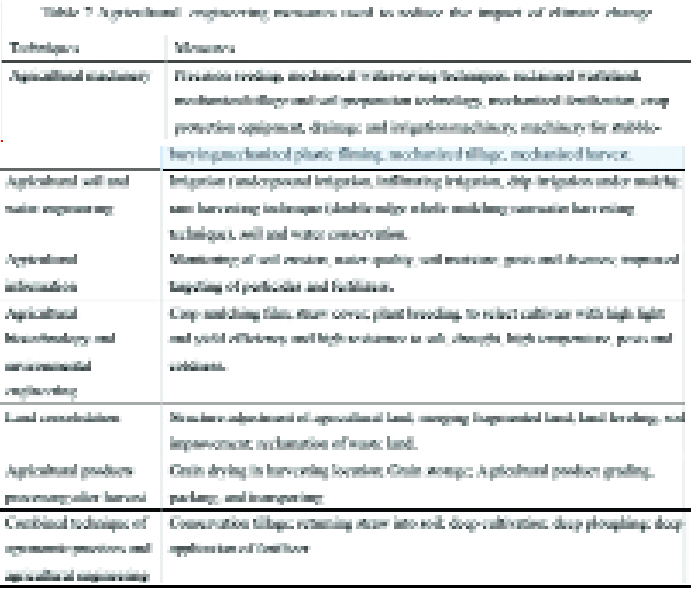Impact of climate change on crop production and agricultural engineering technological countermeasures used in mitigation in China
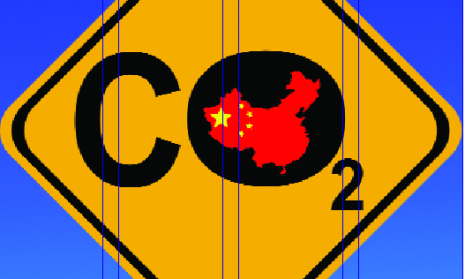
Summary1
A statistical analysis of the independent effects of a number of environmental factors on agricultural crop production in China indicated that climate change, measured as trends of temperature rise, sunshine decline and precipitation fluctuation, had a depressing effect overall.
The increase in temperature is most obvious in the Northeast and North of China with increased precipitation in southern China while the decline in sunshine duration is most significant in the Northwest.
The frequency and intensity of extreme weather are increasing; On the one hand, the increased temperature results in the northward and westward expansion of the cropping boundary, thereby increasing the area of arable land by 4.91% of the total in the Northeast from 1981 to 2010; the fertilization effect of CO2 will also increase wheat, rice, and maize yield by about 37%, 15% and 10%, respectively.
On the other hand, the temperature rise and precipitation decline aggravate drought and water shortage in most parts of the north, thereby lowering the yield of maize, wheat and soybean by 1.73%, 1.27%, 0.41%, respectively from 1980 to 2002.
Crop yield loss caused by agricultural meteorological disasters can be as high as 15% (1980-1993); The expectation is that crop yield loss in China owing to climate change is estimated to be 5%-10% in the next 30 years if no control measures are taken.
Agricultural engineering, which has shown great benefits to China’s agriculture, is coping, and will cope effectively with adverse effects of climate change on crop production.
Agricultural machinery and land consolidation can stabilize, or increase, planting acreage and water-saving; and irrigation can enhance drought resistance of food production.
Agricultural machinery contributed to 18.33% crop yield profit in 1996. An agricultural advisory service provides early warning and forecasting of agricultural disasters.
Artificial drying of harvested products can reduce product losses during transporting and processing. Conservation tillage and sub-soiling, during which straw is returned to soils, can also increase food production.
In fact, agricultural engineering techniques used in mitigation have made a great contribution to crop yield, compensating for the adverse impacts of climate change.
Key words
climate change, China, agricultural engineering technology, mitigation measures, crop production
Introduction
Since the 1950s there has been a global warming trend which is escalating (1,2,3,4).
China’s warming trend is particularly evident over the last 50 years, during which the surface air temperature has increased 1.1oC, i.e. 0.22oC per decade – values significantly higher than those of global levels (5).
China has a large population and relatively little arable land, accounting respectively for 20% and 9% of the world total. Food security is thus a major challenge. Both natural and social factors can affect agricultural production.
Social factors include agricultural management, agricultural technology, economy, labour and agricultural policies.
Their impact on crop yield cannot be ignored. However, natural factors including climate, environment, water resources and arable land are highly associated with agricultural production.
Climate is the main uncontrollable factor affecting crop production (6). This paper considers the effects of the climatic trends on grain production in China by summarizing published data, analyzing regional changes and their relationship with grain production. It also considers the effect of mitigating factors in current use (mainly agricultural engineering technologies) in China.
1 Grain producing regions and regional climate change in China
1.1 Classification of grain producing area
China, located in eastern Asia and the western Pacific (73°33'-135°05'E, 3°51'-53°33'N), covers an area of about 9.6 million km2 with a complicated range of landforms and climates ranging from tropical monsoon to temperate continental.
For the purposes discussed here grain production is divided into six regions: the Northeast, the Northwest, North China, the middle and lower-reaches of Yangtze River, South China, and the Southwest (Fig. 1).
The Northwest is dominated by a continental air mass, giving it cold winters, hot summers, drought and little rain. The Northeast and North China are affected by a temperate monsoon climate and characterized by cold and dry winters, and hot and rainy summers.
The middle and lower-reaches of Yangtze River and other subtropical regions are affected by a subtropical monsoon climate and often have dry winters with a low temperature, and rainy hot summers.
South China and the Southwest are dominated by a tropical monsoon climate, with hot weather throughout the year and with most rain in the summer.
1.2 Regional climate change
Climate change in China's grain producing areas has been associated with rising temperatures, declining sunshine, and fluctuating precipitation (Table 1) (7).
Over the 46 years, the average air temperature has been higher in the northern part of China than the southern part of China and highest in the Northeast and the Northwest with an increase of mean temperature more than twice that of the Southwest.
Sunshine duration decreased in the southern part of China about two to three times faster than in the north. The decline in sunshine was most obvious in the Southwest.
Precipitation has decreased in northern China and increased in southern.
The temperature rise has been highest in the Northeast and precipitation fluctuates greatly throughout the country.
The precipitation in North China is lower in summer and autumn (8). These changes aggravate the hot and rainy weather with little sunshine in the southern part of China, and also exacerbate drought conditions of northern China, despite relieving the coldness of northern China, thereby leading to a negative influence on agricultural production.
As global warming continues it is likely that, weather extremes (minimally, the event lies in the upper or lower ten percentile of the distribution or has destructive potential) such as unusually high or low temperature, prolonged dry or wet conditions, and heavy precipitations occur more frequently and intensively.
During the years of 1956-2009, the highest and lowest daily air temperature each month in mainland China increased at a rate of 0.1 and 0.6oC/10a, respectively, while hot days with a daily maximum temperature > 25oC has significantly increased at a rate of 2.1 days/10a (9).
Over the past 20 years, drought conditions in the Northeast and North China have been more severe, droughts in the eastern part of the Northwest, most of North China, and the eastern and southern part of China have increased, and floods in the middle and lower-reaches of the Yangtze River are becoming more serious (5).
Over the last 50 years, the occurrence of heavy precipitation events in the Northwest have been frequent, the torrential rain days in the middle and lower-reaches of the Yangtze River have increased, and thus it is necessary to pay close attention to the threat posed by floods in summer (5,10).
In a word, in recent years, China’s climate is characterized by temperature rise, a reduction in the duration of sunshine, and increased frequency of extreme weather events, and there are obvious regional differences in these changes over the vast territory of China.
However, average temperature rises in the lower temperature regions can increase the cropping area; but rising temperatures also increase the risks of severe agricultural pest attacks, intensified drought, and water shortages on arable land.
2 Effects of climate change and agricultural meteorological disasters on main grain production
Climate change has the potential to affect all aspects of crop production in China.
2.1 Positive impact of climate change on agricultural production
Higher mean temperature is likely to increase the planting area and thus increases the area of the arable land in northern and the western part of China, by increasing the length of the growing season.
In the past 30 years, the northern cropping boundary has moved northward and westward for winter wheat in the Northeast, North China and the Northwest, and northward for double cropping rice (twice/year); but the boundary extends mostly towards the southeast for winter wheat and summer maize in the middle and lower-reaches of the Yangtze River (11).
Overall, for the northern part of China, the extension of the planting boundary is most obvious in the northeast region (12), and these changes may increase crop acreage, or enhance grain production capacity in each region.
Zhao Jin et al. (13) showed that, compared with 1961-1980, the planting northern boundary of spring maize in the Northeast in 1981-2010 extends northward by 158.3-285.8 km, leading to an increase of 3.87 x 104 km2 in the planting acreage and accounting for about 4.91% of the total arable land area in the Northeast.
Liu Zhong et al. (14) showed that the increase in rice, maize and spring wheat yield of China has resulted from expansion of the planting area, while that of winter wheat is dominated by an increased planting area and yield per unit area, which may result from arable land expansion of the northern boundary.
Agricultural production emits greenhouse gases which contribute to climate warming and the CO2, as a carbon fertilizer, increases grain production. Greenhouse gas emissions (CH4, N2O and CO2 etc.) from industrial development, human population, commercial fertilizers and livestock production continue to increase, and exacerbate global warming.
Tan Qiucheng (15) calculated greenhouse gas emissions from agricultural production in China to be ca 1.6 Tkg of CO2 equivalent in 2009, to an increase of 52% compared with 1980.
Total emissions increased by approximately 1.5% per annum, of which 25% were CH4, 52% N2O, and 23% were as CO2. GHG emissions from rice cultivation and livestock production were 0.14 and 0.43 Tkg of CO2e, accounting for 9% and 27% of the total, respectively (15).
Xiong Wei et al. (16) simulated the effect of natural factors such as CO2 on crop yield using CERES models and found that the increase of CO2 can significantly improve crop yield.
The CO2 fertilization effect will be greatest in winter wheat with an increase of yield up to about 37%, followed by rice and maize with the maximum yield increases of 15% and 10%.
2.2 Negative impact of climate change on grain production
Changes in temperature, precipitation and sunshine affect crop yields (maize, rice, soybean, & wheat).
Between 1980 and 2002, the yield/ha of maize, wheat and soybean due to climate trends decreased by 1.73%, 1.27%, and 0.41%, respectively, but increased in rice by 0.56% (17).
Regional variations in wheat yield have been larger, followed by maize and rice. Yields have fallen for maize in the Northeast, the northern part of the North China Plain and the Loess Plateau (18).
From 1980 to 2002, maize yield declined in the Northeast by up to 20%, and was also considerable in the northern and eastern parts of China, while the increase in rice yield was significant in the southern and northeastern part of China (Fig 2) (17).
Temperature is an important factor affecting maize yield and an increase during the growing season can lead to yield decline (19). For rice, precipitation increase, temperature rise, and sunlight reduction can shorten the growth period and lead to a yield decline (20).
Li et al. (21) applied the methods of first-differences and removal of a linear time trend to analyze climate change’s impact on wheat from 1978 to 1995 and found that temperature rise had decreased yield in Hubei and Jiangsu provinces by 37%-41%, and that increased precipitation led to negative impacts of 23%-60% on yield in several provinces, including Guangdong in the southeastern part of China due to reduced sunlight and crop drowning; but yield variations are not correlated with precipitation and temperature fluctuations in most other Chinese provinces.
Overall, the impact of global warming on China's grain production is negative, and the grain yield decline of China as a whole could be up to 5%-10% in the next 30 years (22).
Meanwhile, increasing temperature increases some pests and diseases, accelerates the decomposition of soil organic matter, reduces soil fertility and soil moisture.
In the last 40 years, drought conditions from temperature rises and precipitation reduction has posed a threat to wheat growth in North China. For rice, the high temperature can induce seed set, and reduce crop yield.
In 2003 for example, rice in the middle and lower-reaches of the Yangtze River had poor seed set with a yield decline of 30%-70% (23).
2.3 Negative impact of agro-meteorological disasters on grain production
Extreme weather can result in varying degrees of damage to crop growth and yield.
Studies have shown that compared to 2002, the extreme weather in 2003, such as a cold winter and spring, reduced sunshine or high rainfall, can delay the sowing and jointing date, respectively for 4-6 and 12-15 d, reduce the number of stems per unit area by 29.1%, and decreased biomass, leaf area index, spike numbers, leading to a reduction of winter wheat yield by 9.57% (24); a high mean temperature in the filling stage of winter wheat in May (higher than 21oC) cuts the yield of winter wheat by more than 13%, while severe drought results in a reduced winter wheat yield of <4 t/ha (25). In general, maize has a weaker capacity to cope with climatic fluctuation than either rice or wheat (26).
Agro-meteorological disasters, extreme weather events, pests and diseases occur frequently and now expand to a wider area with the more severe damage, increasing the instability of agricultural production and seriously threatening the safety of China's grain production.
Shi Peijun et al. (27) showed that crop yield damage caused by drought, wind, hail, frost and pests during the period 1980-1993 accounted for about 15% reduction in the total yield, (40%) nearly half of which was caused by extreme climatic fluctuation.
In the past 50 years, both flood and drought in China have caused annual grain yield loss of 2.06 million tonnes, i.e. an average grain loss of 4.7% a year (28), showing a trend of deterioration (Fig. 3) (29).
Snow at the beginning of 2008 in the southern China led to crop damage over 11.8 million ha in 21 provinces, and to crop failure over 168.67 ha.
From a regional perspective, grain yield losses caused by weather had been greater in northern than in southern China, more severe in the north, the northeast, and in the northwest, where the grain loss trend had been most severe (29).
It is estimated that the yield in China of wheat, rice and maize will decrease in the next 30 years (22).
2.4 Uncertainty of climate change impact on agricultural production
Agricultural production is a complex dynamic system dependent on soil fertility, crop species, climate, technology, management and other factors. Studies on the relationship between climate change and agricultural production contain many uncertainties.
1) Effects of temperature and precipitation on yield are partly dependent on soil conditions. In a 3 year experiment, the yield-increasing effect of nitrogen fertilizer for maize is significant when precipitation is higher than 280 mm during the growing season, but is not significant when precipitation is less than 280 mm (30). In addition, soil drought also affects the yield.
2) Analysis suggests that 5.15% variation in grain yield in China is due to grain production policies (such as policies of land use, tax, insurance, and allowance) between1978-2012, for which wheat yield is most sensitive (26); Chinese rice yields are affected by technological change (such as fertilizer, tillage, variety breeding, cultivation, irrigation), social (policy, market, et al.) and natural (climatic fluctuation) factors, accounting for 28%-35%, 15%-17%, and 48%-56%, respectively, of rice yield variation (31).
3 Agricultural engineering technological countermeasures to cope with climate change
Agronomic and agricultural engineering technology can help to ameliorate the effects of climate change (see Table 2).
3.1 Agricultural engineering
Each of the techniques listed in Table 2 plays important role in agricultural production.
The elasticity coefficient (indicating contributions of input factors to yield) of machinery investment, and land and irrigation technique to grain yield is 0.4 and 0.18, respectively (32).
These show the positive effects of agricultural machinery on production by replacing hand labour and increasing the planted area.
Hong Renbiao et al. (2000) estimated that agricultural machinery contributed 18.33% to crop yield profit in 1996 based on yield profit, (33).
Yang Qing et al. (2000) showed that the contribution of agricultural machinery to crop yield profit increased from 16.6% in 1990 to 21.1% in 1998 in Shaanxi province (34).
In addition, utilization of drainage and irrigation machinery reduced by 10% in drought-suffering areas and by up to 20% in flood-suffering areas in 1996 (35).
Water-saving and irrigation are also helpful in increasing production efficiency, and more importantly, by reducing the effects of drought on grain yield.
A survey reported that 70% of grain, and 90% of vegetables and fruits are produced from irrigated fields in China (36).
A 2008-2009 academic report of Chinese agricultural engineering development revealed that agricultural water allocation schemes could add 129 billion tonnes of irrigation water through comprehensive application of water-saving, irrigation, and rain-harvesting techniques (37).
Increased irrigation water resources has led to crop yield increases, especially in arid areas. Hou Peng et al. (38) estimated the potential of irrigation to increase maize yield in Heilongjiang.
The potential was highest in the southwestern part of the region and decreased to the east and north.
Those regions with high cumulative temperatures (> 2500 oC • d) and low precipitation (350 mm during the growing season), amounting to 430 mm/an., are ready for the establishment of irrigation.
Early-warning systems, help reduce the risk of pests and of agricultural meteorological disasters, and have been successfully practiced (39).
Obviously, the resource of arable land is lessened by social and economic development.
Comprehensive land use planning can increase the area of arable land. By the end of 2005, about 1.58 million ha of land in China have been subjected to consolidation, resulting in an additional 370,000 ha farmland (40). this para might fit better later in the text, but I have not moved it as it would affect the ref. number.
It is estimated that inappropriate, or the absence of processing post-harvest causes a loss of about 17 % of vegetables and can cause up to 10% loss of harvested grains, about 80% of which is lost at the harvest site, equivalent to the produce of 1.8 Mha of land (41).
Agricultural products processing techniques can dry, clean, grade, pack, store, and transport agricultural products by mechanical, or physical, methods with high efficiency, and they can reduce product loss during the harvesting and transportation and can improve their utilization efficiency.
3.2 Agronomic practice and agricultural engineering
Appropriate agronomic practices to increase crop yield vary in different regions of China.
1) Conservation tillage
A 10-year experiment in the Loess Plateau of Shanxi province and in dry farming areas of Jinzhong and Jinnan basin showed that conservation tillage can reduce soil erosion by around 80%, increase soil organic matter by 0.03%-0.06%, and increase grain yields by 13%-16% (40). In the central Songliao Plain, no-till and wide and narrow row spacing can significantly increase maize yield compared with rotary tillage and ploughed fallow, and thus the former method is recommended for arid areas (42). In the loess Plateau, a series of tillage techniques for rainfall harvesting, ridge-furrow-mulching and supplementary irrigation are effective measures to cope with an arid environment and improve crop yield, which is summarized by Rui-Ying Guo and Feng-Min Li in World Agriculture (43).
2) Deep ploughing with returning straw into soil
Studies in North China showed that compared to conventional tillage only, subsoiling can increase winter wheat by 8.04%. However, when straw is ploughed into the soil, subsoiling can increase soil moisture content and wheat yield by 16.07 % and 11.45%, respectively (44).
3.3 Other agricultural techniques – chemical fertilizer, pesticide, and mulching film
The beneficial effects of commercial fertilizers, pesticides and plastic film have become less positive in recent years in China.
Increasing incidence of pesticide tolerance has increased pest damage and normal plastic mulching film left in the soil detracts from the physical property and organic matter of the soil, causing pollution and reducing soil fertility, which reduces grain yield.
Less use of normal plastic film, replaced by degradable plastic film, or mechanization of residual plastic recycling technology are countermeasures for agricultural plastic film residue pollution (45).
Technical approaches to improve fertilizer management at farm level have been summarized by David Powlson et al. (2014) (46). It is necessary to control the amount of fertilizers applied, control pesticides and plastic mulching film to maximize crop yield, whilst avoiding damage to the environment.
It is necessary to develop a sustainable fertilizer programme to relieve and offset the negative influence of climate change on grain production while taking full advantage of the CO2 fertilization effect.
4 Conclusions
1) There is clear evidence of a general rise in surface air temperature in China, especially in the north region where the mean annual temperature increase has been 1.6 times that in the southern region over the last 40 years.However, changes in precipitation rate vary, with a decline in the North East, the North West, and North China but with an increase in the middle- and lower-reaches of the Yangtze River. Changes in temperature and precipitation rate are most significant in the Northeast. The frequency and intensity of extreme weather are both increasing.
2) Climate change has positive and negative impacts on China’s grain production. The increased temperature allows the northward and westward expansion of the cropping boundary, thereby increasing the cold area of arable land. An increase in arable land area accounts for 4.91% of the total in the Northeast between 1981 and 2010. The fertilization effect of CO2 is estimated to have increased grain yield by 37%, 15% and 10% for wheat, rice, and maize, respectively. The negative effects of climate change on grain production include temperature rise and precipitation decline which aggravate drought and water shortage in most part of the north, affecting crop yield. Overall, the negative impact of climate change is dominant in China, with yields of maize, wheat and soybean reduced by 1.73%, 1.27%, 0.41%, respectively, from between 1980 to 2002. Grain yield loss is most severe in the Northeast, and the potential for maize production is decreasing in the Northwest and North China. Wheat yield has declined in the Yangtze River and in South China. Crop yield loss caused by meteorological disasters can be as high as 15% (1980-1993). The overall crop yield loss in China, over the next 30 years, owing to climate warming is estimated to be 5%-10% if no measures are taken.
3) Agricultural engineering technology, or in combination with agronomic practices, is an effective measure to increase both the area cultivated and crop yields. Agricultural machinery plays an important supporting role in ensuring the steady increase in planting acreage. It contributed 18.33% to crop yield profit in 1996. Water-saving and irrigation can reduce the effects of drought and information systems can provide early warning and forecasting of impending problems. Land consolidation can increase the available land area and effective arable land. New post-harvesting practices of agricultural products reduce product loss during harvesting, transporting and processing. Conservation tillage in arid and semi-arid areas has significant effects of water retention, soil conservation, and on the effectiveness of fertilizers. It reduces soil erosion by around 80% and has increased grain yield by 13%-16% in Shanxi province. In the Northeast and North China, subsoiling plus ploughing straw into soils has been shown to also increase wheat yield by 11.4%. Therefore, in the future, development and application of advanced agricultural engineering technology will be an important method of maintaining and increasing crop yield in China.
References
1. Intergovernmental Panel on Climate Change. Fifth Assessment Report(AR5).[2014-07-08] http://www.ipcc.ch/
2. Foster G, Rahmstor S. (2011) Global temperature evolution 1979-2010. Environ Res Lett 6,doi:10.1088/1748-9326/6/4/044022
3. Hansen J, Ruedy R, Sato M, et al. (2010) Global surface temperature change. Rev Geophys 48, RG4004
4. Santer BD, Painter J F,Mears C A, et al. Identifying human influences on atmospheric temperature.PNAS Early Edition, 2012[2013-06-01].http:www.pnas.Org/cgi/doi/101073/pans.1210514109
5. Ding Yihui, Ren Guoyu, Shi Guangyu, et al. (2006) National assessment report of climate change (I): Climate change in China and its future trend. Advances in Climate Change Research 2(1):3-8. (In Chinese with English Abstract)
6. Decker WL. (1994) Developments in agricultural meteorology as a guide to its potential for the twenty-five century. Agricultural Forest Meteorology 69:9-25.
7. Pan Gengxin, Gao Min, Hu Guohua, et al. (2011) Impacts of climate change on agricultural production of China. Journal of Agro-Environment Science 30(9):1698-1706. (In Chinese with English Abstract)
8. Ma Jiehua, Liu Yuan, Yang Xiaoguang, et al. (2010)Characteristics of climate resources under global climate change in the North China Plain. Acta Ecologica Sinica 30(14):3818-3827. (In Chinese with English Abstract)
9. Zhou Yaqing, Ren Guoyu. (2010) Variation characteristics of extreme temperature indices in mainland China during 1956-2008. Climatic and Environmental Research 15(4):405-417. (In Chinese with English Abstract)
10. Chen Hui, Shi Xiong, Wang Yongbo. (2001) Climate secular change and base state over the mid-lower reaches of Yangtze River. Scientia Meteorologica Sinica 21(1): 44-53. (In Chinese with English Abstract)
11. Yang Xiaoguang, Liu Zhijuan, Chen Fu. (2010) The possible effects of global warming on cropping systems in China I. The possible effects of climate warming on northern limits of cropping systems and crop yields in China. Scientia Agricultura Sinica, 43(10):2088-2097. (In Chinese with English Abstract)
12. Li Kenan, Yang Xiaoguang, Liu Zhijuan, et al. (2010) Analysis of the potential influence of global climate change on cropping systems in China III: The change characteristics of climatic resources in Northern China and its potential influence on cropping systems. Scientia Agricultura Sinica 43(10):2088-2097. (In Chinese with English Abstract)
13. Zhao Jin, Yang Xiaoguang, Liu Zhijuan, et al. (2014) The possible effects of global warming on cropping systems in China X: The possible impacts of climate change on climatic suitability of spring maize in the three provinces of Northeast China. Scientia Agricultura Sinica 47(16):3143-3156. (In Chinese with English Abstract)
14. Liu Zhong, Huang Feng, Li Baoguo. (2013) Investigating contribution factors to China's grain output increase in period of 2003 to 2011. Transactions of the Chinese Agricultural Engineering 29(23):1-8. (In Chinese with English Abstract)
15. Tan Qiucheng. (2011) Greenhouse Gas Emission in China’s Agriculture: Situation and Challenge. China Population, Resources and Environment 21(10):10 69-1075 (In Chinese with English Abstract)
16. Xiong Wei, Lin Erda, Jiang Jinhe, l. (2010) An integrated analysis of impact factors in determining China's future grain production. Acta Geographica Sinica 65(4): 398-460.
17. Tao F, Zhang Z, Zhang S, et al. (2012) Response of crop yields to climate trends since 1980 in China. Climate Research 54: 233-247.
18. Zhong Xinke, Liu Luo, Xin Liang, et al. (2012) Characteristics of spatial-temporal variation of maize climate productivity during last 30 years in China. Transactions of the Chinese Agricultural Engineering 28(15):94-101. (In Chinese with English Abstract)
19. Wang Liu, Xiong Wei, Wen Xiaole, et al. (2014) Effect of climatic factors such as temperature, precipitation on maize production in China. Transactions of the Chinese Agricultural Engineering 30(21):138-146. (In Chinese with English Abstract)
20. Wang Weiguang, Sun Fengchao, Peng ShiZhang, et al. (2013) Simulation of response of water requirement for rice irrigation to climate change. Transactions of the Chinese Agricultural Engineering 29(14):90-98. (In Chinese with English Abstract)
21. Li S, Wheeler T, Challinor A, et al. (2010) The observed relationships between wheat and climate in China. Agricultural and Forest Meteorology 150:1412-1419.
22. Lin Erda, Xu Yinlong, Wu Shaohong, et al. (2007) China’s national assessment report on climate change (II): Climate change impacts and adaptation. Advances in Climate Change Research 3(suppl): 6-11
23.
24. Xing Suli, Zhang Guanglu, Li Huilong, et al. (2005) Analysis of the winter wheat yield components and causes under the extreme climatic conditions. Transactions of the Chinese Agricultural Engineering ,21(13):212-214. (In Chinese with English Abstract)
25. Sun Ning, Feng Liping. (2005) Assessing the climatic risk to crop yield of winter wheat using crop growth models. Transactions of the Chinese Agricultural Engineering 21(2):106-110. (In Chinese with English Abstract)
26. Liu Zhong, Huang Feng, Li Baoguo. (2015) Analysis on characteristics and influential factors of grain yield fluctuation in China based on empirical mode decomposition. Transactions of the Chinese Agricultural Engineering, 31(2):7-13.
27. Shi Peijun, Wang Jingai, Xie Yun, et al. (1997) A preliminary study of the climatic change, natural disasters of agriculture and grain yield in China during the past 15 years. Journal of Natural Resources 12 (3): 199-203. (In Chinese with English Abstract)
28. Zhou Wenkui. (2012) Impact of climate change on Chinese food production and its countermeasures. Nanjing: Nanjing Agricultural University. (In Chinese with English Abstract)
29. Li Maosong, Li Zhangcheng, Wang Daolong, et al. (2005) Journal of Natural Disasters. Journal of Natural Disasters 14(2):55-60. (In Chinese with English Abstract)
30. Zhao Jingkao, Lu Jing, Gu Siyu, et al. (2011) Effects of precipitation and nitrogen on spring corn yield in black soil regions. Transactions of the Chinese Agricultural Engineering 27(12):74-78. (In Chinese with English Abstract)
31.
32. Huang Zhen. (2014) Analysis of influencing factors of grain production in China—Based on C-D production function and ridge regression. Taxation and Economy 196(5):50-54 (In Chinese with English Abstract)
33. Hong Renbiao, Yang Bangjie, Jia Shuanxiang. (2000) Mechanization profit portion estimation in China’s plant products industry. Transactions of the Chinese Agricultural Engineering 16(6):60-63(In Chinese with English Abstract)
34. Yang Qing, Zhu Ruixiang, Zhang Jie, et al. (2000) Mechanization profit portion estimation in plant products industry in Shaanxi province. Transactions of the Chinese Agricultural Engineering 16(6):64-67(In Chinese with English Abstract)
35.
36. Wu Kai, Lu Bu, Yuan Zhang. (2006) The recent developments and the contribution of farmland irrigation to national grain safeness in China. Journal of Irrigation and Drainage 25(4):7-10. (In Chinese with English Abstract)
37.
38. Hou Peng, Chen Xinping, Cui Zhenling, et al. (2013) Evaluation of yield increasing potential by irrigation of spring maize in Heilongjiang province based on Hybrid-Maize model. Transactions of the Chinese Agricultural Engineering 29(9):103-112. (In Chinese with English Abstract)
39. Wang Chunyi, Wang Shili, Huo Zhiguo, et al. (2005) Progress in research of agro-meteorological disasters in China in recent decade. Acta Meteorologica Sinica 63(5):659-671. (In Chinese with English Abstract)
40.
41. Ge Yiqiang, Chen Ying, Zhang Zhenhua. (2005) Development of fruit, vegetable and characteristic resources processing industry of China[J]. Storage and Process 27(2): 1-3. (In Chinese with English Abstract)
42. Yin Xiaogang, Liu Wuren, Zheng Hongbin, et al. (2012) Soil tillage practices coping with drought climate change in central region of Songliao Plain. Transactions of the Chinese Agricultural Engineering 28(22):123-131(In Chinese with English Abstract)
43. Rui-Ying Guo, Feng-Min Li.(2014) Agroecosystem management in arid areas under climate change: Experiences from the Semiarid Loess Plateau, China. World Agriculture 4, 2:19-29.
44. Lü Meirong, Li Zengjia, Zhang Tao, et al. (2010) Effects of minimum or no-tillage system and straw returning on extreme soil moisture and yield of winter wheat. Transactions of the Chinese Agricultural Engineering 26(1):41-46(In Chinese with English Abstract)
45. Yan Changrong, He Wenqing, Neil C. Turner, et al. (2014) Plastic-film mulch in Chinese agriculture: Importance and problems. World Agriculture 4, 2:32-36.
46. David Powlson, David Norse, David Chadwick, et al. (2014) Contribution of improved nitrogen fertilizer use to development of a low carbon economy in China. World Agriculture 4, 2: 10-18.
1 Foundation: Special Scientific Research Fund of Agricultural Public Welfare Profession of China(201203002); CAST (China Association of Science and Technology)Promotion Project for Elite Journals
Author: Zhao Aiqin, postdoctor in Chinese Academy of Agricultural Engineering (CAAE). Email:zhaoaiqin@tcsae.org
Zhu Ming, ProfessorPresident of Chinese Society of Agricultural Engineering, President of CAAE. Email: mingzhu@agri.gov.cn
Wei Xiuju:Professor of CAAE. Email:weixj06@163.com
Figures
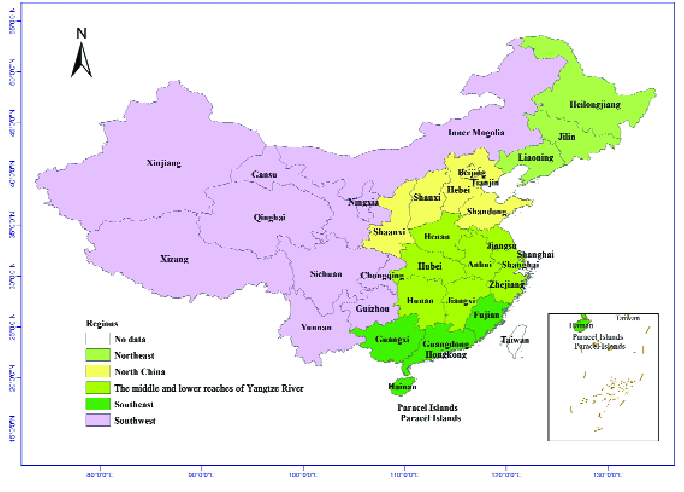
Fig 1 Classification of the six main regions and its provinces in China
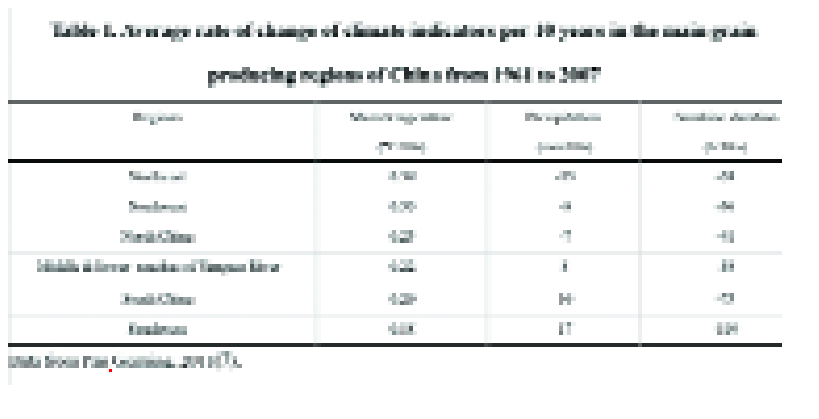
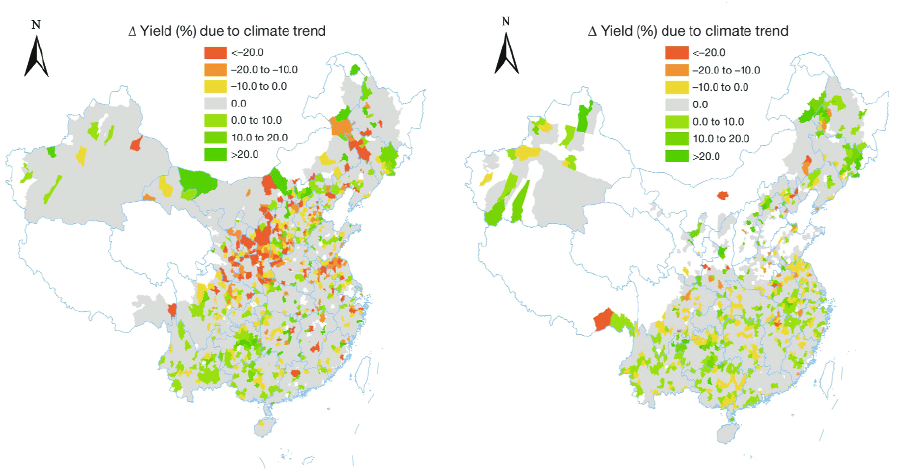
Fig 2 Crop yield change during 28 yrs due to trends in climate (temperature, solar radiation & precipitation) during 1980-2008, based on median estimate (From Tao et al., 2012)
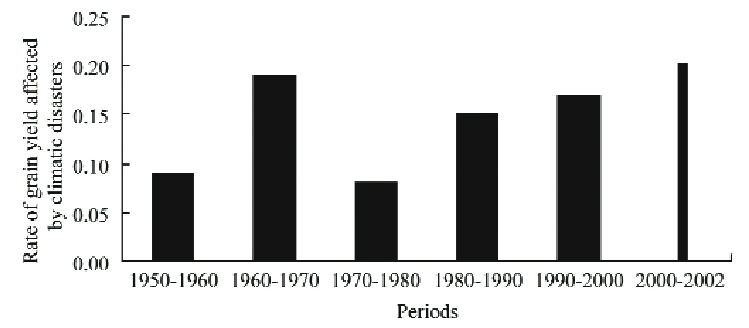
Fig 3 Proportion of grain yield adversely affected by climatic disasters in China from 1950 to 2002, indicating an increasing rate/period (From Li Maosong et al., 2005)
